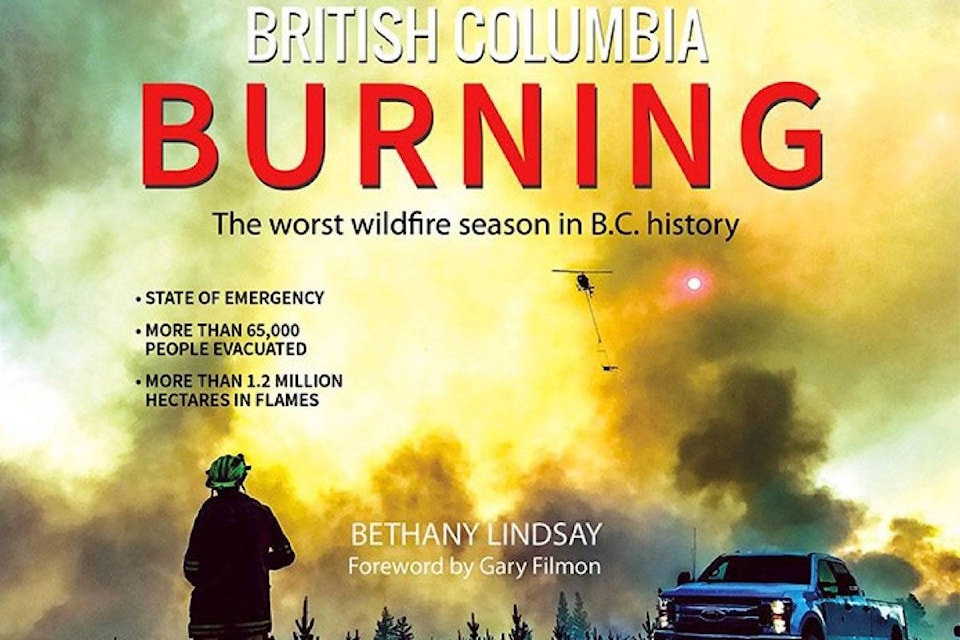British Columbia Burning: The worst wildfire season in B.C. history
by Bethany Lindsay
MacIntyre Purcell Publishing Inc., 106 pp, pb, $19.95
Is it too soon for a book about the most devastating wildfire season in B.C.’s history? British Columbia Burning, by journalist Bethany Lindsay, comes less than a year after the wildfires that consumed more than 1.3 million hectares of land, destroyed dozens of homes, triggered the largest evacuation in the province’s history, and caused tens of millions of dollars in damage, with economic effects that will be felt for years.
For many people directly impacted by the fires, the book may prove to be too painful. As a balanced overview of the disaster, however, British Columbia Burning is a well-written and well-researched book that not only looks at the wildfire season of 2017; it examines how we got to that point, and what we might expect going forward.
Lindsay constructs the book like a novel, using the stories of several people immediately impacted by the fires as threads which weave throughout the book. We follow Ashcroft Reserve resident Angie Thorne from the time the Elephant Hill wildfire is first spotted, through the realization that she has lost her home, and the aftermath; Langley firefighter Shawn Cahill, who did everything he could to save his beloved cabin at Loon Lake; Greg Nyman, a rancher south of Clinton, who is highly critical of the controlled burns used by the BC Wildfire Service (BCWS) to combat the blaze; Chief Joe Alphonse of Tl’etinqox First Nation; chief fire information officer Kevin Skrepnek; and veteran BCWS firefighter Hugh Murdoch. Mike Flannigan, a professor of wildland fire at the University of Alberta, describes the conditions that led to, and then fed, the fires.
READ MORE: An interview with British Columbia Burning author Bethany Lindsay.
After examining contributing factors to last year’s wildfires—including an unusually wet early spring and an unusually dry June—Lindsay turns her attention to the start and spread of the major fires throughout the province, then follows them through the long, hot summer of 2017. There are stories of loss and heartbreak, anger and frustration, but also tales of courage, determination, and even joy, as when Ester Spye is reunited with her cat Socks, 52 days after last seeing her beloved pet on the Ashcroft Reserve.
Lindsay’s writing is clear and direct, and she avoids the temptation to over-dramatize events that were already dramatic enough (save for one melodramatic reference to the Elephant Hill wildfire biding its time like some sort of intelligent predator and planning its attack). Towards the end she examines in more depth what got the province to the point where last year’s fires burned so large and long, and what can be done to mitigate such events in the future.
The tragedies at Boston Flats and Pressy Lake are given somewhat short shrift (and a picture on page 93, identified as Boston Flats, does not appear to be of that community), while Lindsay repeats the misinformation that Ashcroft was evacuated. The book is lavishly illustrated with some stunning photographs chosen by photo editor Kelly Sinoski.
These are small complaints, however, when balanced against the book as a whole, which does an admirable job of depicting last year’s wildfires and the people and communities affected by them; sections about the First Nations experience, in both preventing fire and dealing with its many realities, are especially interesting. British Columbia Burning is an excellent overview of a series of events that will not be forgotten by those who lived through them, and essential reading for anyone who wonders where we go from here.
editorial@accjournal.ca
Like us on Facebook and follow us on Twitter
